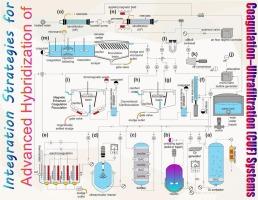混凝-超滤系统的高级混合:对一体化战略的重要技术经济审查
IF 6.3
2区 工程技术
Q1 ENGINEERING, CHEMICAL
引用次数: 0
摘要
混凝预处理已成为低压膜工艺不可或缺的组成部分,共同构成了一种具有成本效益的高效水处理解决方案,尤其有利于发展中经济体。本综述对传统混凝超滤(CUF)工艺的先进混合技术进行了重要的技术经济评估,以克服其局限性并应对该领域新出现的挑战。关于此类混合处理工艺的术语、工艺选择和分类,一直存在混乱。本研究试图批判性地回顾和整理近期影响 15 种关键混合 CUF 工艺前景的著作,以便在看似杂乱无章的近期文献中建立一个系统框架。研究分析了影响 C+UF 组合工艺的关键因素,确定了机遇,并提出了有效的整合策略。未来的研究可能会优先考虑尚未充分探索的参数,如可持续性指标、有毒副产品形成潜力(TBP-FP)、脉冲加药策略、层内絮凝体电荷分布、温度-超顺磁性、界面自由能、特定气体纳米气泡、定制混合絮凝剂以及可扩展性。本综述强调了若干此类因素对混合 CUF 系统性能的连带影响,旨在为提高系统效率、可持续性和适应性指明方向。本文章由计算机程序翻译,如有差异,请以英文原文为准。

Advanced hybridization of coagulation–ultrafiltration systems: A critical techno-economic review of integration strategies
Coagulation pretreatment has become indispensable for low-pressure membrane processes, together forming a cost-effective and efficient water treatment solution, particularly beneficial for developing economies. A critical techno-economic evaluation of advanced hybridization of the traditional coagulation ultrafiltration (CUF) process to overcome its limitations and address emerging challenges in the field is presented in this review. Confusion persists regarding nomenclature, process selection, and categorization of such hybrid treatment processes. This study seeks to critically review and organize recent works shaping the outlook of fifteen key hybrid CUF processes to establish a systematic framework within the seemingly disordered array of recent literature. Key factors influencing the combined C + UF process are analyzed, opportunities are identified, and effective strategies for integration are proposed. Future research may prioritize the investigation of underexplored parameters such as sustainability metrics, toxic by-product formation potential (TBP-FP), pulse dosing strategies, intralayer floc charge distribution, temperature-superparamagnetism, interfacial free energy, specific gas nanobubbles, tailored hybrid flocculants, and scalability. This review highlights the cascading influence of several such factors on hybrid CUF system performance and aims to delineate pathways for advancing system efficiency, sustainability, and adaptability.
求助全文
通过发布文献求助,成功后即可免费获取论文全文。
去求助
来源期刊

Journal of water process engineering
Biochemistry, Genetics and Molecular Biology-Biotechnology
CiteScore
10.70
自引率
8.60%
发文量
846
审稿时长
24 days
期刊介绍:
The Journal of Water Process Engineering aims to publish refereed, high-quality research papers with significant novelty and impact in all areas of the engineering of water and wastewater processing . Papers on advanced and novel treatment processes and technologies are particularly welcome. The Journal considers papers in areas such as nanotechnology and biotechnology applications in water, novel oxidation and separation processes, membrane processes (except those for desalination) , catalytic processes for the removal of water contaminants, sustainable processes, water reuse and recycling, water use and wastewater minimization, integrated/hybrid technology, process modeling of water treatment and novel treatment processes. Submissions on the subject of adsorbents, including standard measurements of adsorption kinetics and equilibrium will only be considered if there is a genuine case for novelty and contribution, for example highly novel, sustainable adsorbents and their use: papers on activated carbon-type materials derived from natural matter, or surfactant-modified clays and related minerals, would not fulfil this criterion. The Journal particularly welcomes contributions involving environmentally, economically and socially sustainable technology for water treatment, including those which are energy-efficient, with minimal or no chemical consumption, and capable of water recycling and reuse that minimizes the direct disposal of wastewater to the aquatic environment. Papers that describe novel ideas for solving issues related to water quality and availability are also welcome, as are those that show the transfer of techniques from other disciplines. The Journal will consider papers dealing with processes for various water matrices including drinking water (except desalination), domestic, urban and industrial wastewaters, in addition to their residues. It is expected that the journal will be of particular relevance to chemical and process engineers working in the field. The Journal welcomes Full Text papers, Short Communications, State-of-the-Art Reviews and Letters to Editors and Case Studies
 求助内容:
求助内容: 应助结果提醒方式:
应助结果提醒方式:


